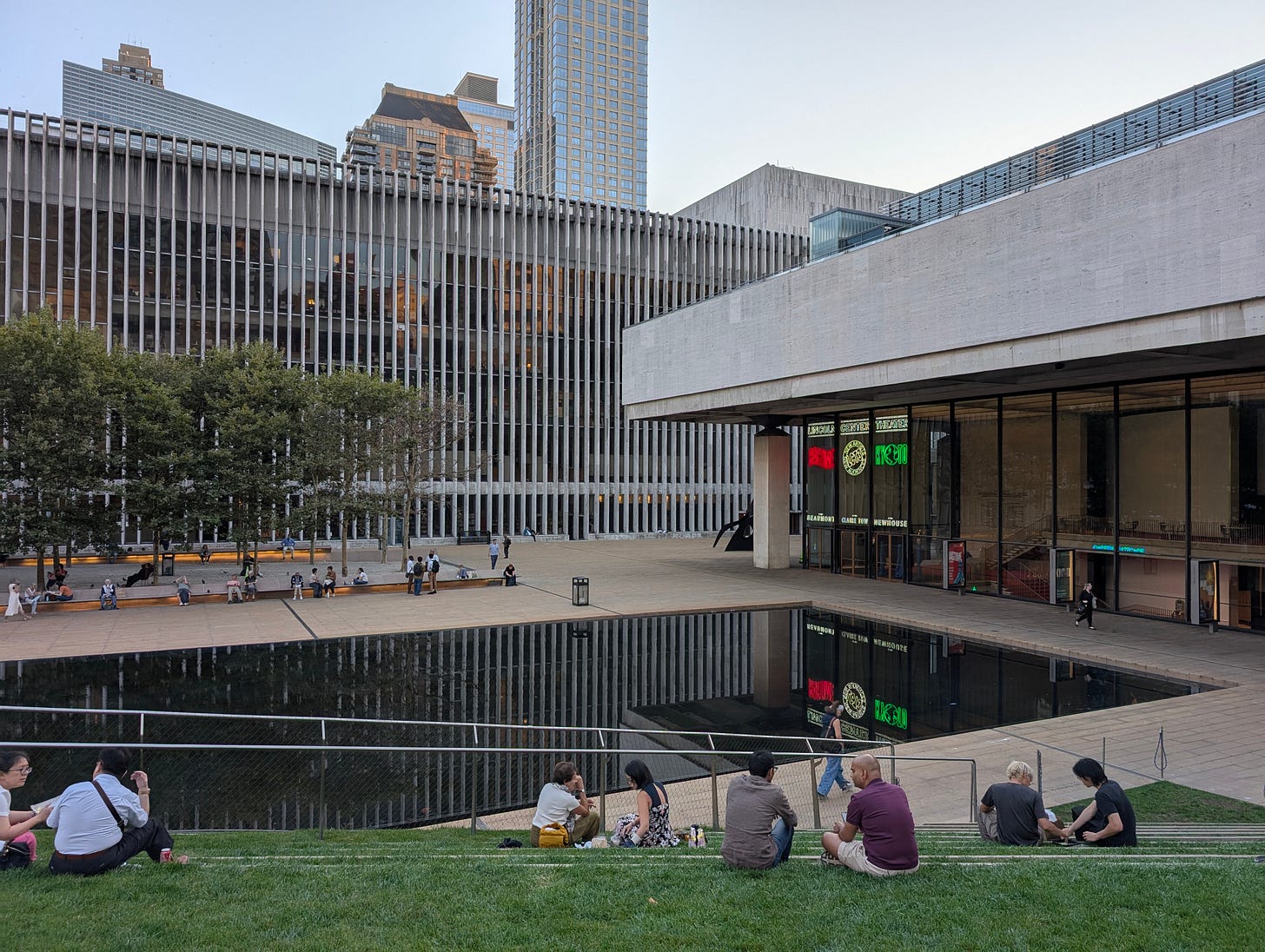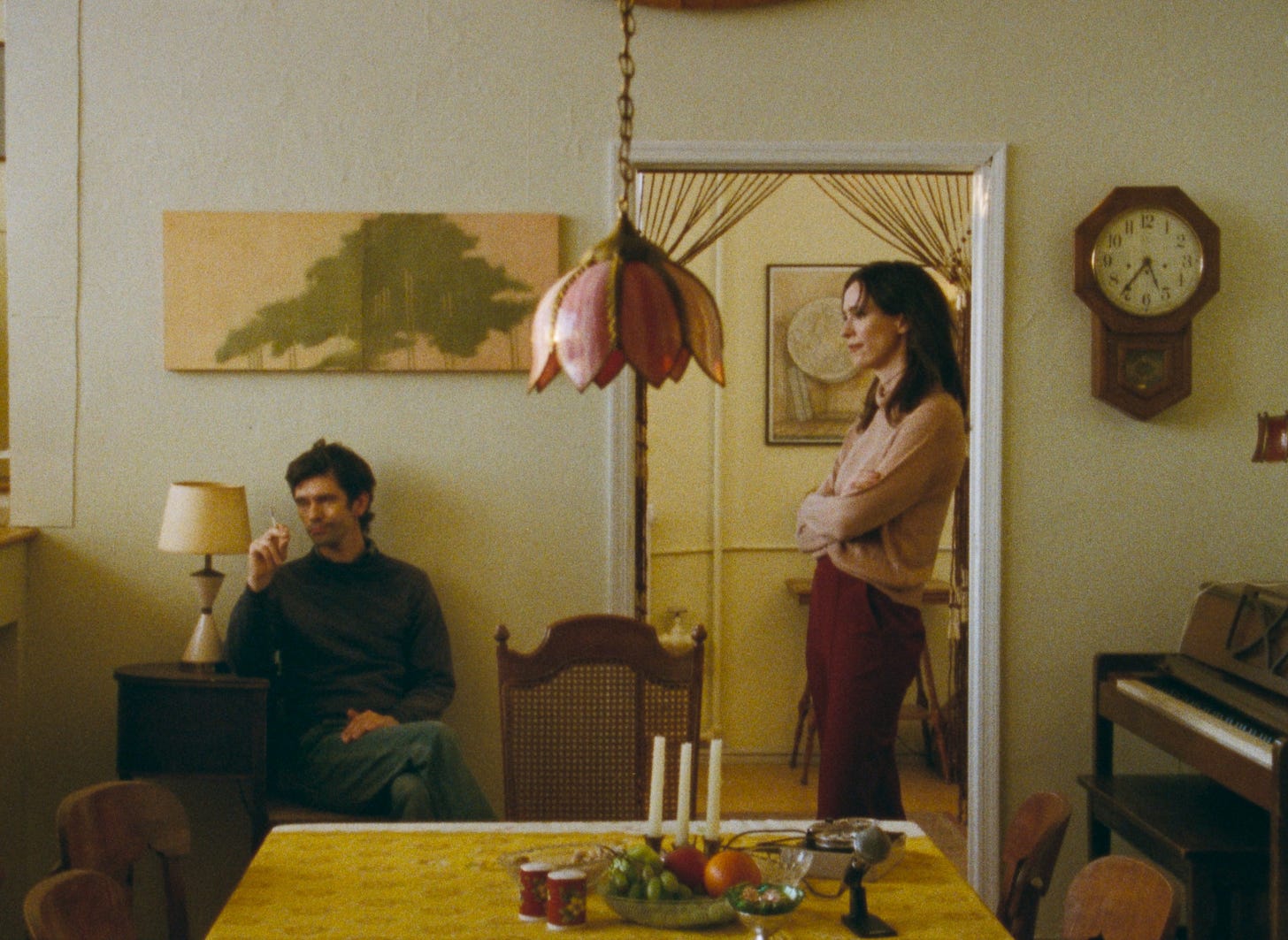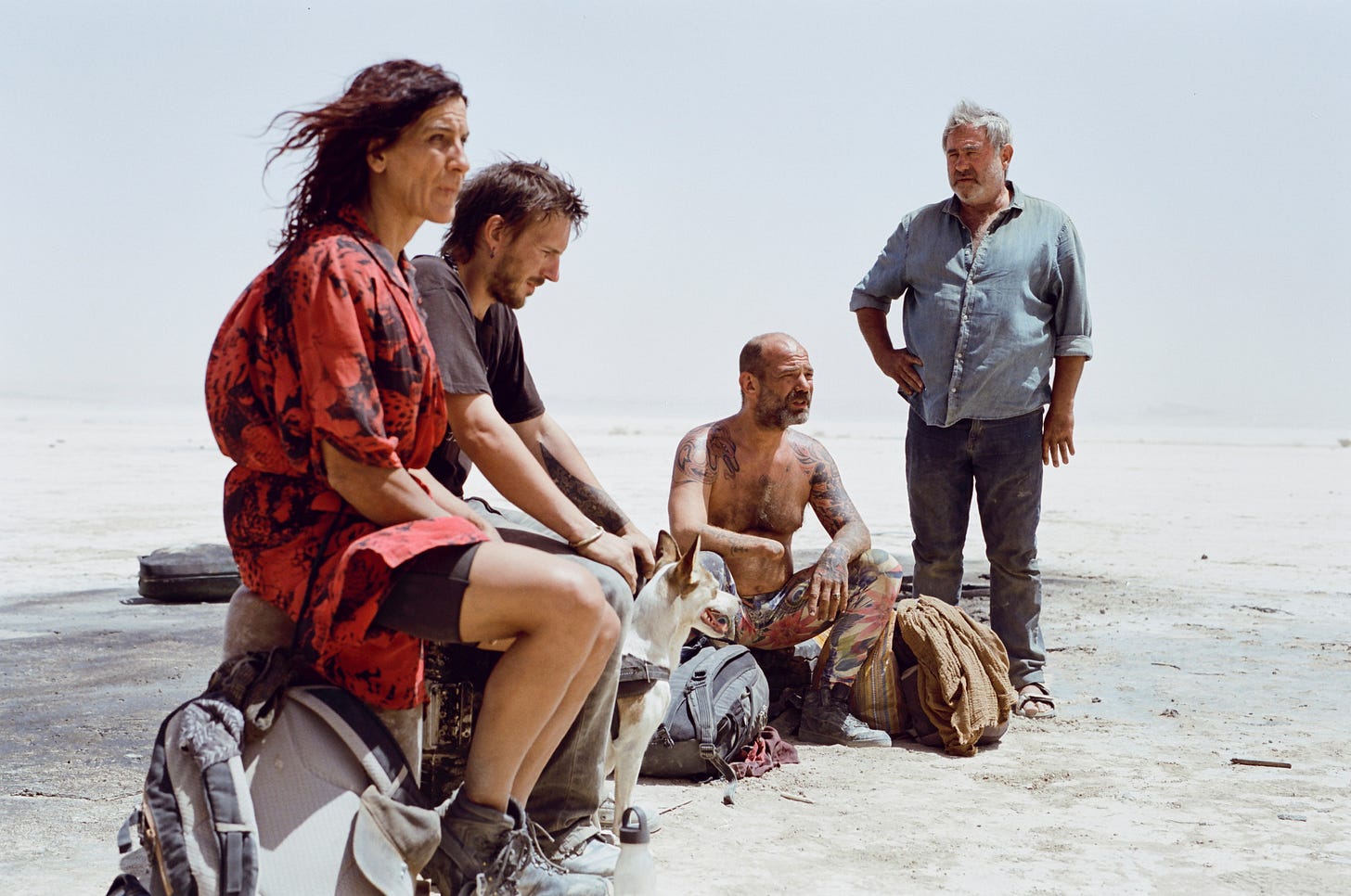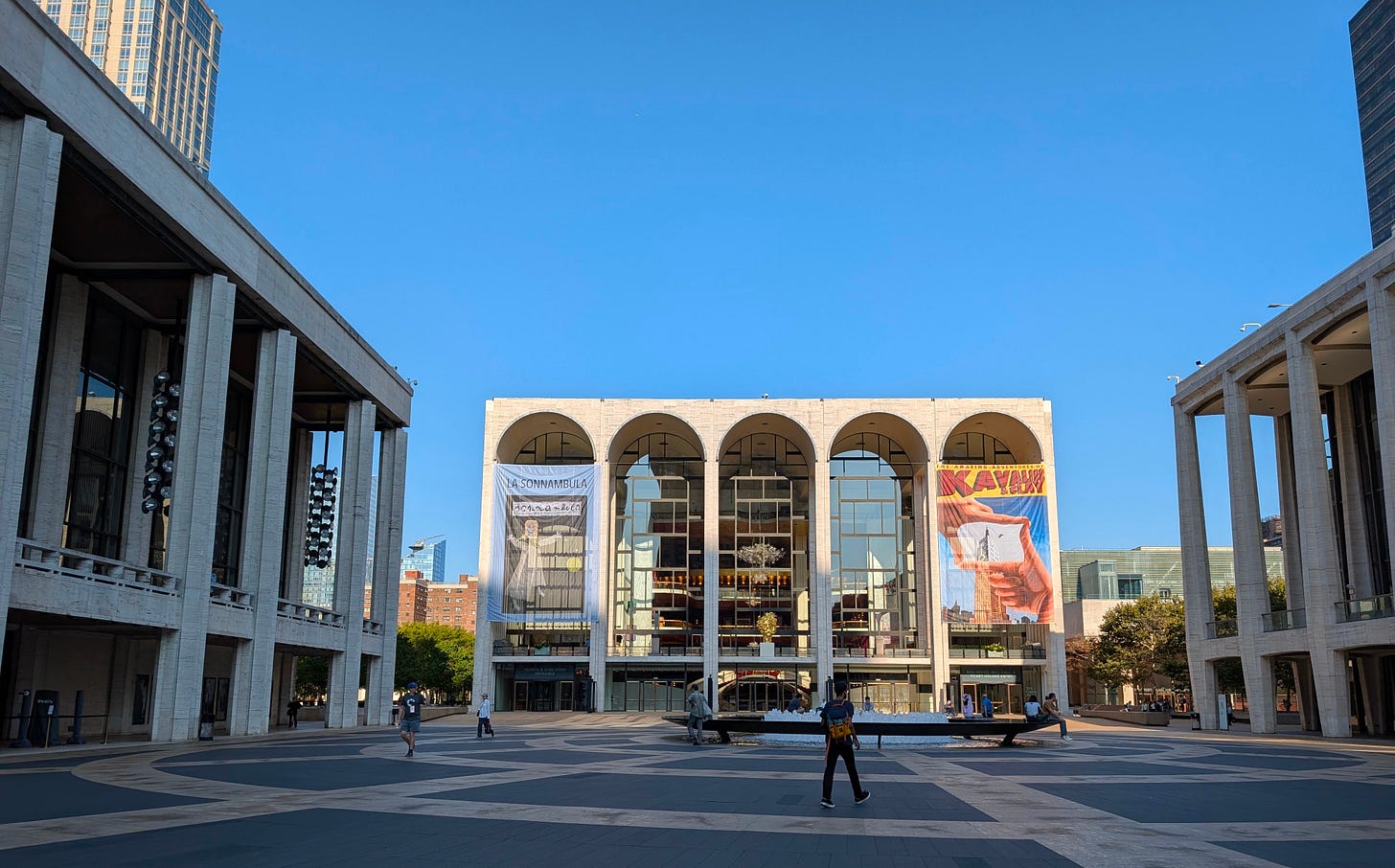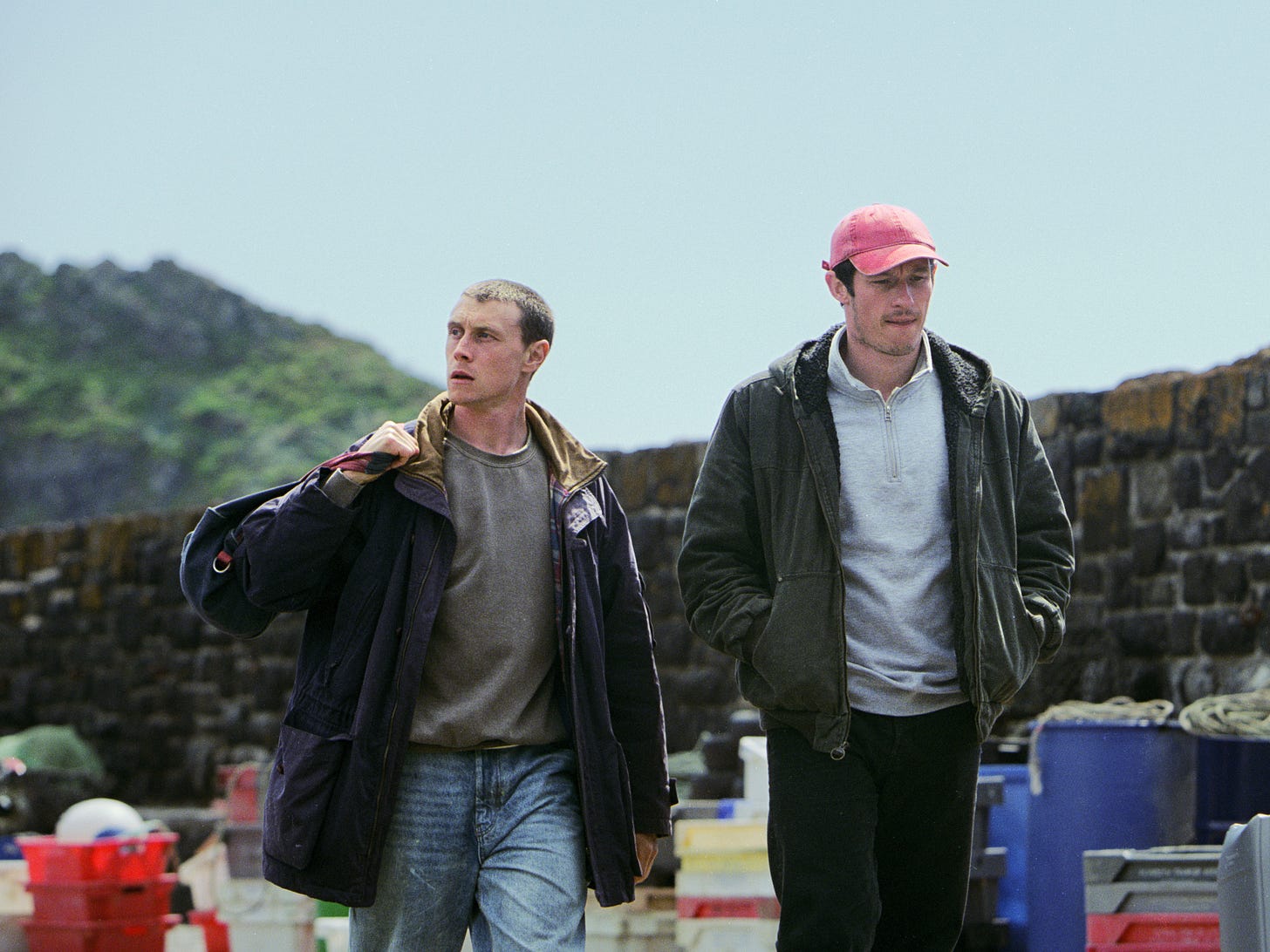NYFF Dispatch 2: Andrew Truong’s Day
Back in Peter Hujar’s Day, Magellan captained the Rose of Nevada on a journey across the Sirāt bridge, with a stowaway Secret Agent.
The next two days of New York Film Festival press screenings had some hotly anticipated titles that, for the most part, missed the mark for me. There’s only one movie in this batch that I really recommend 🙁, which puts me at odds with the critical consensus.
(Remember, these are initial impressions, not super thought out critical reviews. But my goal is the same with the longer reviews I write: tell you about the movie, what I thought of it, and even if I wasn’t into it, highlight the aspects that may attract a viewer with different tastes.)
Thursday, September 18
No clouds in the sky, as Jay-Z once said. The bright and sunny weather is completely different from yesterday. Fortunately I didn’t have to spend much time waiting in line.
I skipped the morning screening, I Only Rest In the Storm, which had an imposing runtime, but the few who did turn out for it told me it was pretty solid.
I was in the office before and for lunch ate some leftover oxtail bò kho (I really wish the theaters could make a microwave available it would make things so much easier). Then I headed up to the Lincoln Center for Day Two of the press pre-festival. Peter Hujar’s Day starts in ten minutes, so I’m not really expecting to get in and would have been okay with having the extra time to do some more work.
But I managed to get a seat anyway. (Is this airport theory?) The theater was actually not too full, which I suppose wasn’t too surprising since the film has been screening to critics over the past couple weeks.
Peter Hujar’s Day
Screens September 27, 28, and October 1. Opens in theaters November 7 via Janus Films.
Exactly what it says on the tin: a full recounting of Peter Hujar’s day, specifically December 18, 1974. The new film from Ira Sachs adapts an interview between the legendary New York photographer and his friend Linda Rosenkrantz, who wanted to compile the daily lives of artists in the scene. (The original audio tapes are considered lost but a transcript was rediscovered.) There isn’t much talk about the artistic process or anything too heady. Rather the focus is on quotidian mundanities: scheduling meetings, getting Chinese takeout, watering plants by filling up a coffee pot from the bathtub tap “because the pressure is faster.” From all this, one can see how Peter’s keen sense of observation of everyday life informed his work. The discursive style is not dissimilar to these very dispatches, but he notices more things and describes them with more wit than I do; there is a reason why Peter Hujar was a well-regarded artist and I am not.
This 76-minute movie is a cozy conversation between friends, and a certain subset of art freaks will really dig it. For me, it felt like watching a podcast on YouTube. (I hate podcasts.) Ben Whishaw and Rebecca Hall, two Brits, have technically perfect but labored impressions of a mid-century New Yawk accent. Too often it feels like they are merely reciting their characters rather than inhabiting them. Perhaps it’s the formality of the interview format that hems them in.
The film is beautiful to look at, and not just because of Whishaw and Hall’s fine features. It all takes place in a spacious, split level apartment on the far reaches of the West Village (standing in for Rosenkrantz’s real apartment up on 94th Street). Production designer Stephen Phelps created a set worthy of an Architectural Digest tour; light streams in and gives the tasteful furniture and knicknacks an enviable glow.
Tasting Notes: Peter describes the Chinese takeout he had for dinner the previous day, and a late supper in the film has Linda eating what looks like a Nutella sandwich while Peter scars down what I think is a pot pie? Artists are not usually known for being gourmands.
In the lobby, I debriefed with fellow attendees and opinions were split. Some were really into it, others felt distanced. This is one of those movies that’s really your thing, or really not. My cousin Kevin saw it earlier this week and really dug it, but he is the kind of person who reads literary journals for fun.
The Secret Agent
Screens September 27, 28, and October 7. Opens in theaters November 26 in NY and December 5 in LA via Neon.
A hotly anticipated title since its premiere at Cannes, where the jury gave awards to director Kleber Mendonça Filho and actor Wagner Moura (in his first Brazilian movie in nearly a decade). Set in 1977, “a period of great mischief” when Brazil’s dictatorship was just beginning to falter, it’s a densely plotted spy thriller without professional spies. On the run from political persecution, technological researcher Marcelo (Moura) arrives in the bustling city of Recife at the height of a particularly violent Carnival festival. He’s there to retrieve his young son and wait for passports that will let them flee the country. Among the dangers are corrupt cops, a severed leg that attacks the city’s young lovers, and sold-out screenings of Jaws.
The Secret Agent is a kaleidoscopic portrait of a chaotic time and place, layered with history and context going all the way back to initial colonization by the Portuguese. It is certainly a meaningful movie for the Brazilians who have tirelessly stumped for this film on the internet. And it’s very much a personal epic, as the director himself was born in Recife. I’m afraid to piss off the Brazilians, but this just didn’t land for me and I haven’t really been able to articulate why. A second watch may be needed, but sometimes words just fail to describe why a film didn’t work for me. Everyone else I spoke with was really into this movie.
It was not a total loss though: I adored the stylish soundtrack of Brazilian and American pop, the worn-in but fashionable costumes, and frequent appearance of the era’s distinctive orelhãos—pay phones ensconced in a banana yellow shell. There is also a sudden shift in perspective that opens up the movie’s overarching theme of historical memory and the secrets lost with each generation. And it doesn’t hurt that Moura is very easy on the eyes.
In terms of the Oscars narrative, fans of The Secret Agent are hoping it can build on the breakout success of I’m Still Here earlier this year, when it nabbed surprise nominations for Best Picture and Actress and won the award for International Film. There are some parallels: both pictures are set in the same time period and affirm the importance of keeping the historical memory alive. But stylistically they are very different. I’m Still Here was an example of a Hollywood-style classic historical drama that was very Academy-friendly. The Secret Agent is intentionally messier and more sprawling, and much more violent.
Tasting Notes: not that much food content, though we see a couple hitmen eating pastéis de bacalhau (salt cod fritters) at a bar, and caipirinhas are consumed in at least one scene. The layman is probably most familiar with Brazilian cuisine through those all-you-can-meat palaces like Fogo de Chão, which is not my preference when selecting a restaurant; I’m not into steakhouses in general. I’m big into pão de queijo. Last year I had some excellent ones in Astoria at the aptly named New York Pao De Queijo but I’m not super familiar with Brazilian cuisine so hit me with some recommendations.
Touched some grass (literally) before heading back in1, hoping the final movie of the day wouldn’t disappoint.
Sirāt
Screens October 1, 2, and 11. One-week awards qualifying run in NY and LA starting November 14, with an official theatrical release beginning January 26 via Neon.
In search of his missing daughter, Luis (Sergi López) ventures into the Moroccan desert with his son Esteban (Bruno Núñez), following a lead that she would be attending a secret rave there. She is nowhere to be found, so the out of place duo spends a couple days observing the party and passing out flyers to the dancing Europeans. Then World War III breaks out and the army arrives to evacuate everyone. The duo splits off and follows a gang of renegade ravers deeper into the Sahara in search of another underground party. Needless to say, things go wrong, and director Oliver Laxe imposes trial after trial upon his characters.
Sirāt is a techno journey to the end of the world, and not one for the faint of heart. The slow burn suspense becomes so unbearable one can only laugh at fate’s cruelty. There are so many references to The Wages of Fear that you might as well call it “The BPMs of Fear.” (Inspiration is also taken from The Sheltering Sky.) The specific politics are a bit messy (one early image seems to reference a certain electronic dance party that was interrupted by men with guns, the final image could have a particularly uncharitable interpretation), but by and large it is a decent allegory about the westerners whose futile attempts to ignore the world at large will end up having to face it anyways.
There are quite a few movies in this year’s NYFF lineup about Europeans entangled in Africa, but I suspect Sirāt is the only one with a soundtrack so loud that the walls of the Walter Reade Theater constantly rattled during my screening. Large portions of the soundscape are dedicated to four on the floor kicks and slithering basslines from Berlin-based DJ Kangding Ray. (“You ain’t got no fuckin’ Yeezy in your Sirāt-o?”) A quality sound system is essential; headphones and a laptop won’t cut it.
I’m usually against the puritanical fears about “spoilers,” but Sirāt has a plot that ought to be experienced fresh (besides what I have just written). I would have loved to attend the premiere at Alice Tully Hall just to experience everyone’s reactions because once this movie goes sicko mode, it will be an unforgettable experience. I walked out of the theater a bit dazed but also invigorated and I wasn’t alone in that feeling.
Tasting Notes: Ayahuasca and LSD.


Satisfied with my third movie of the day, I grab ice cream at the nearby Van Leeuwen with Keith and Doug. I get two of the seasonal flavors: Italian hazelnut and pumpkin cheesecake.
Then I went home, with not much time before having to sleep and do this all over again. I was going to heat up some leftovers but the ice cream made me pretty full, so I just roasted some broccolini and called it dinner.
Friday, September 19
It sure is second summer! I write a little bit on my train ride back up to the Lincoln Center. Today was pretty brutal, energy wise. As an unreformed night owl, being out of the house before 9 AM is not something I’m used to and I had a headache all morning, which really did not do my first movie any favors.
Magellan
Screens October 9, 10, and 13. Release plans TBA by Janus Films.
Gael García Bernal inhabits the titular role in this revisionist history from slow cinema practitioner Lav Diaz. It is much welcomed to have a Filipino perspective on the story of the Portuguese explorer—and his downfall at the hands of a legendary tribal chief whose existence is likely mythical. But on the large I found the experience of watching Magellan to be as punishing as the transcontinental voyage depicted midway through the film.
Some folks I talked to afterwards found reward in the drawn out pace and painterly imagery, but I can tell you that I was not the only person in that room who took brief naps throughout the screening. (Sleeping during slow cinema is not a sin; in fact, the delirium usually enhances the experience.) This movie clocks it at 160 minutes, but Diaz has referenced a nine-hour cut, which to me sounds like a threat. With these types of durational experiences, I find them either enthralling or grueling, Magellan happens to be the latter.
Tasting Notes: The film journeys between Malacca (present-day Malaysia), Lisboa (Portugal), Seville (Spain), Cebu (Philippines), and the vast oceans in between. Iberian colonization had a big influence on the cuisines of the Pacific Islands, a subject that can’t be conscientiously unpacked in this format. I don’t think anyone should feel guilty about enjoying Malaysian and Filipino food, but as someone who enjoys the French influence on Viet food maybe I’m not really one to talk.
I skip the next movie (fragmentary Neapolitan doc Below the Clouds) and take a long lunch break. My friend Jen lives twenty blocks uptown and works from home, and she grants me two blessed hours of relaxing on a couch. On the way up I go to Xi’an Famous Foods: N1 regular spicy. It’s been a long time since I had Xi’an.
Jen and I catch up for a bit then we both turn to our laptops and get some work done. I wish I lived this close by because the prospect of three more weeks of this isn’t sounding too great right now, even though my commute is pretty easy. I take a much needed nap. Then it’s time for me to venture back down to Lincoln Center. The heat is getting to me a bit.
Rose of Nevada
Screens October 1, 2, and 9. Seeking distribution.
Old wounds of grief are re-opened in a secluded Cornish village when a fishing trawler (from which this film takes its name) suddenly appears after having vanished thirty years ago, with its missing crew members remain lost at sea. Needing money to fix a leaky roof, Nick (George MacKay) takes a job on the boat, along with Liam (Callum Turner), another young fellow, and a veteran fisherman who goes by Murkey and has forgotten his own name (Francis Magee). But when the Rose of Nevada returns to shore three days later, the trio finds themselves marooned in 1993; they’re mistaken for the people who had disappeared all that time ago. Despite the premise, it isn’t plotty time loop sci-fi but rather a hard-scrabble examination of a declining way of life and the sacrificial side-effects of rewriting history. It really helps that MacKay is one of the few rising British stars who don’t have iPhone face.
Rose of Nevada is a cryptic journey that not only looks and sounds like it was made thirty years ago, but feels like it was dug out of a time capsule from the period. This fealty to the old ways of doing things is a trademark for Mark Jenkin, who notably used Bolex cameras and hand-processed the 16mm film in his debut feature Bait. Fellow critic Chris Cassingham pointed out to me that Jenkin has become sort of a golden boy for the future of British independent film. That aside, for this film it makes for a nifty bit of cinematic time travel in a movie that uses it as a plot device.
Tasting Notes: “There’s only one way to gut a fish: head to arsehole.” The perfect meal pairing for this movie is quite obvious, even better if you catch it yourself. The primary species in Cornwall include mackerel, pollock, and sea bass, all of which are fairly easy to get here in New York, but for true verisimilitude go for locally sourced seafood. My favorite way to cook a whole fish is to stuff it with some herbs and lemon slices and broil each side until it’s nice and charred. The inside will steam itself without overcooking the flesh.
I have a keen interest in the next movie in the lineup, Romería (having been to one myself during last year’s trip to Spain) but Dan scheduled his monthly movie night this evening so it is sadly pre-empted. (We watched David Cronenberg’s Spider, which is somehow his bleakest film?)
And that concludes Week -1 of the New York Film Festival!
In case you missed it:
Next dispatch:
NYFF Dispatch 3: One Movie After Another
It’s also one NYFF dispatch after another! My tendency to be exhaustive is getting exhausting, for myself and (I assume) the reader. If I can help it, the post that comes after this one will have much shorter blurbs instead of these capsule reviews.
See photo at top of this post.



